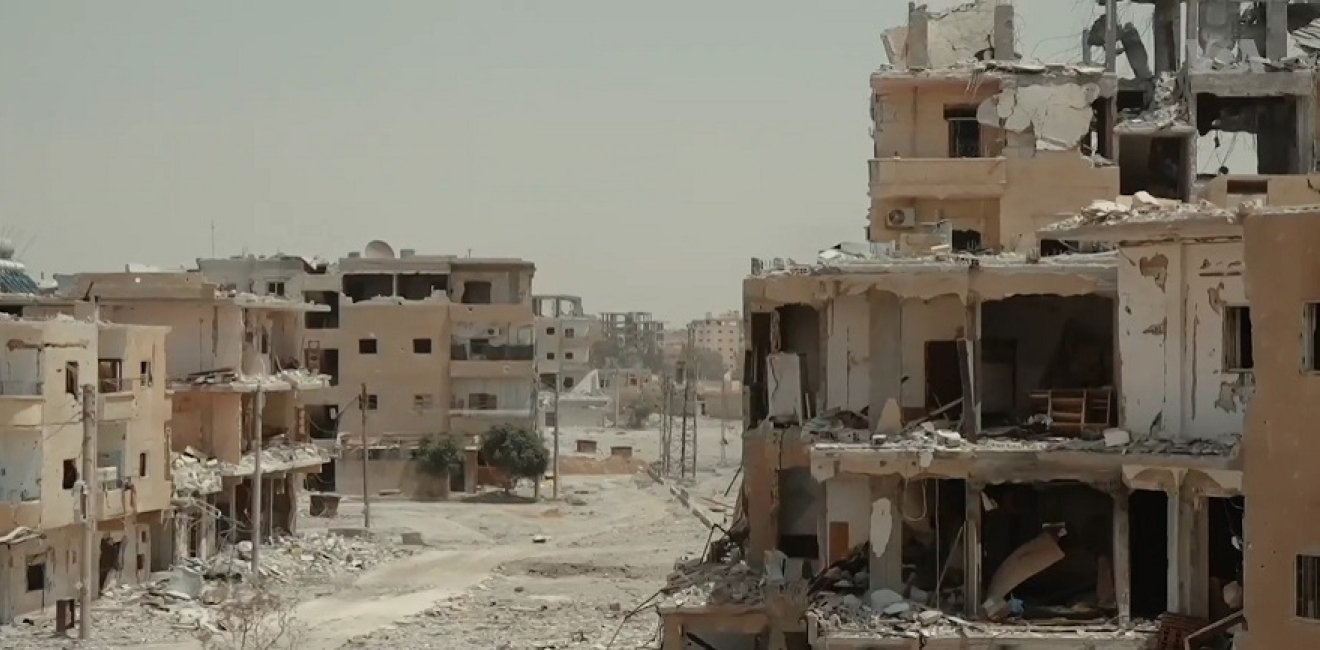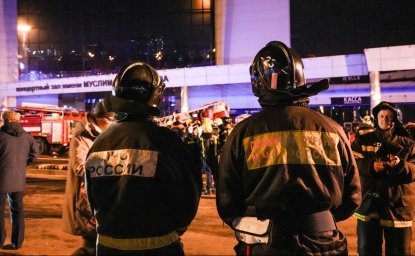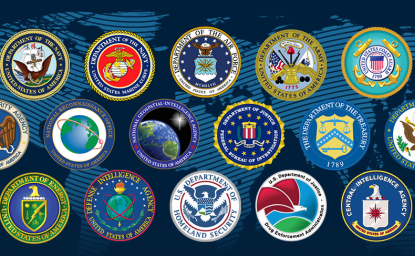ISIS After the Caliphate
What's left for ISIS post-caliphate? A rundown of its residual fighting force, financial resources and propaganda machine.
What's left for ISIS post-caliphate? A rundown of its residual fighting force, financial resources and propaganda machine.

At its territorial peak in fall 2014, the Islamic State controlled 41,000 square miles in Iraq and Syria―a territory larger than the size of Indiana―and ruled over eight million people. It attracted more than 40,000 foreign fighters from 120 countries; it also mobilized over 25,000 from inside Syria and Iraq. Economically, it was self-sustaining through oil sales, taxes, looting, smuggling, and extortion. It averaged $81 million a month in revenues in spring 2015.
1/5-ICYMI--ISW looks at “ISIS Military Operations During Ramadan: A Forecast for 2015.” http://t.co/aUvNjlnWMq pic.twitter.com/5r3HRnf8f0
— ISW (@TheStudyofWar) June 8, 2015
By November 2017, the ISIS caliphate had imploded after the loss of 98 percent of its territory. It lost its two biggest properties: Mosul, Iraq’s second largest city, in July, and the northern Syrian city of Raqqa, its nominal capital, in October. More than 60,000 fighters had been killed, over 130 leaders eliminated. More than 7.7 million people had been liberated. ISIS revenues had also plummeted—to $16 million a month by spring 2017.
“The caliphate is what drew so many of these foreign fighters to join ISIS and what makes it a global network,” Brett McGurk, special presidential envoy for the Global Coalition to Counter ISIS, told reporters. “They try to fund their so-called affiliates around the world from the resources that they pick up in Iraq and Syria. We have dramatically targeted and degraded their ability to resource themselves. We’ve dramatically degraded their ability to get foreign fighters into Syria. It’s almost impossible for them to do that now.”
SYRIA
ISIS, which had its roots in al Qaeda in Iraq and then the Islamic State of Iraq, regrouped in Syria in 2013. It conquered Raqqa, a city of more than 220,000, in January 2014. Raqqa became the center for ISIS planning, financing, execution, and inspiration of terrorist activities worldwide, including attacks in Paris, Berlin and others, U.S. officials said. It later captured Manbij in the north and Deir Ezzour in the east. Manbij became a center for the mobilization and training of foreign fighters. Deir Ezzour was pivotal for cross-border operations and smuggling. At the end of 2014, the caliphate controlled roughly a third of Syria.
After a four-month campaign, ISIS was ousted from Raqqa on October 20, 2017 by the U.S.-backed Syrian Democratic Forces. The SDF was a local militia dominated by Kurds but included Arabs and other ethnicities. An estimated 2,500 Islamic State fighters were in Raqqa at the beginning of the battle. Some 400 fighters surrendered to SDF forces, but most were killed inside the city. Deir Ezzour fell shortly after on November 3. Surviving fighters from ISIS, known in Arabic as Daesh, retreated to the desert borderlands in the eastern Euphrates Valley between Iraq and Syria.
Abu Kamal, a small town on the Euphrates River along the Syria-Iraq border, was the Islamic State’s last major stronghold. The Syrian army and pro-regime forces captured the town on Nov. 8, 2017. Syria declared victory over ISIS the next day. But two days later, ISIS cells retook half of Abu Kamal. Syrian forces regained control on November 19. The liberation of Abu Kamal “signals the general fall of the terrorist Daesh organization’s project in the region,” the Syrian military said in a statement.
The U.S.-led coalition behind Operation Inherent Resolve heralded the military campaigns. “Daesh's loss of Mosul and now Raqqah are turning points for the terrorist organization whose leaders grow ever more distant from a dwindling number of terrorist adherents,” it said. “Residents were forced to live under a brutal regime that routinely carried out public executions, extortions billed as "taxation," and forced conscriptions. In January, ISIS was actively plotting terrorist attacks against our allies and our homeland in Raqqa.”
IRAQ
The ISIS blitz in Iraq began in January 2014. It first seized western Fallujah. By June 10, it captured Mosul. On June 29, Abu Bakr al Baghdadi declared an Islamic caliphate in Iraq and Syria—and himself caliph. At its height, the Islamic State controlled 40 percent of Iraq, including Tikrit and Ramadi in central Iraq and Tal Afar in the northwest near the Syrian border.
ISIS did not take any new territory, however, as of May 2015. It began to lose ground when Iraqi Security Forces retook Tikrit in April 2015, followed by Ramadi in December. The biggest turning point was the liberation of Mosul on July 10, 2017, after a costly and destructive nine-month campaign. Tal Afar was liberated a month later. ISIS lost its last city in Iraq, al Qaim, on the border with Syria, on November 3, 2017. The U.S.-led coalition provided critical support in daily airstrikes; military advisers helped coordinate Iraqi strategy.
In early December, Iraqi forces drove the last remnants of ISIS from the country. Iraqi Prime Minister Haider al Abadi declared victory over the Islamic State on December 9, 2017. "Honorable Iraqis: your land has been completely liberated. The dream of liberation is now a reality," Abadi said in a televised address. "We have accomlished a very difficult mission. Our heroes have reached the final strongholds of Daesh and purified it. The Iraqi flag flies high today over all Iraqi lands," he added.
"Iraqi Security Forces have fought hard to reach this point," said Maj. Gen. Robert P. White, Commanding General of the Combined Joint Forces Land Component Command - Operation Inherent Resolve. "The threat remains, and there is still hard work to do, but we will continue to stand side-by-side with the Iraqi Government and the ISF to ensure the enduring defeat of ISIS.”
FATE OF FIGHTERS
ISIS was estimated to have more than 60,000 fighters—some 40,000 foreigners and more than 25,000 local recruits—join its militant jihad. The largest contingents of foreign fighters came from former Soviet republics and other Middle East and North Africa countries. The vast majority were killed on the battlefield, according to the U.S.-led coalition. Over a thousand surrendered in Iraq.
At the Islamic State’s peak recruitment, in spring 2015, between 1,500 to 2,000 foreign fighters crossed into Syria or Iraq a month. The “explosive growth in foreign fighter travel to Syria and Iraq surpassed other jihadist conflicts in both scope and magnitude,” a September 2015 Homeland Security Committee report said. By October 2017, it had dropped to almost zero.
Thousands also returned to their home countries. By the time the caliphate collapsed, at least 5,600 men, women and children from 33 countries had already returned home, according to a report by The Soufan Center and The Global Strategy Network.
Over 250 Americans either attempted or succeeded in traveling to join ISIS. Only seven returned from Islamic State territory, although 135 have been charged for terrorism offenses in the United States. By late 2017, 77 had been convicted.
More than 5,000 foreign fighters from European countries―including Belgium, France, Germany and the United Kingdom―joined ISIS, according to a report by the European Commission’s Radicalization Awareness Network (RAN). The study, published in July 2017, found that an average of 30 percent of fighters had returned to European countries. But nearly half of the fighters from Denmark, Sweden and the United Kingdom had returned.
Between June 2014 and February 2017, the Islamic State conducted or inspired approximately 143 terrorist attacks in 29 countries, resulting in the deaths of over 2,000 people, according to The Soufan Center and The Global Strategy Network. RAN reported that ISIS carried out 38 attacks against Western targets between 2014 and 2016.
REMAINING "PROVINCES"
In August 2016, the U.S. National Counterterrorism Center reported that the Islamic State operated in 18 countries, from Mali to the Philippines. By November 2017, after the loss of 95 percent of its caliphate, ISIS still had more than three dozen wilayats, or provinces, on three continents. Some were small. Some were dormant. But all have been deadly. Many fighters fleeing the caliphate were opting to travel to established branches or wilayats in third-countries rather than returning to countries of origin. They include:
ECONOMIC LOSSES
The Islamic State has reportedly generated more revenue than any other extremist organization. The RAND Corporation estimated that ISIS had already amassed more than $875 million before its conquest of Mosul in June 2014. After capturing Mosul, it plundered about $1 billion to $1.2 billion from banks, according to the RAND Corporation. By the end of 2014, it had an annual income of approximately $1.9 billion dollars. In spring 2015, ISIS was averaging $81 million in monthly revenue; 50 percent was levied through taxes and 43 percent was from oil sales, according to a report by IHS Markit, an economic analysis firm in London. The rest was earned through illicit activities.
2014
2015
2016
Taxes and Fees
$300-400 million
$400-800 million
$200-400 million
Oil
$150-450 million
$435-550 million
$200-250 million
Kidnapping
$20-40 million
Unknown
$10-30 million
Antiquities
Unknown
Unknown
Unknown
Foreign Donations
Insignificant
Insignificant
Insignificant
Looting, Confiscations, Fines
500 million – 1 billion
$200-350 million
$110-190 million
Total
$970 million – 1.89 billion
1.035 – 1.7 billion
$520-870 million
But in 2016, the Islamic State’s annual income dropped to a maximum of $870 million. By spring 2017, its monthly revenues were reduced by 80 percent, to an average of $16 million. The drops were largely due to loss of oil resources and a population to tax. “Losing control of the heavily populated Iraqi city of Mosul and oil rich areas in the Syrian provinces of Raqqa and Homs, has had a particularly significant impact on the group’s ability to generate revenue,” said Ludovico Carlino, senior Middle East analyst at IHS Markit.
The Islamic State’s oil production peaked at 56,000 barrels per day (bpd) from July to December 2014, according to a World Bank study. Oil production steadily declined over the next two years, falling to an average of 35,000 bpd in 2015 and 16,000 bpd in 2016. “The results show that Daesh was ineffective in comparison to historical trends at exploiting the fields under its control,” the World Bank concluded. The Islamic State supplemented its income with taxes and looting. But by June 2017, income from taxation was down 79 percent, according to a report by IHS Markit. ISIS oil revenues were down 90 percent, by October 2017, according to the Global Coalition against ISIS.
LOSING THE NARRATIVE
Among extremist groups, the Islamic State has been one of the most sophisticated on social media and in messaging. The movement published or broadcast in 35 languages. It had 40 sites in 2015. But by the spring of 2017, it lost more than half of its internet outlets after losing the cities of Mosul and Fallujah. Mosul was one of the Islamic State’s main media operation centers. Its monthly output of propaganda dropped by 75 percent during the pivotal six months – between November 2016 to April 2017—when it began to lose strategic territory and top propagandists. The Islamic State’s message also shifted―from glorifying the caliphate as a utopia in 2014 to preserving the ISIS mission by fighting, in the region and abroad, in 2017.
After the fall of Raqqa in October 2017, media output dropped “from an average of about 20 to 30 unique media items per day through IS’s official channels on Telegram, down to 10 or less items per day,” according to Mina al Lami, a jihadi media expert at BBC Monitoring. Two of ISIS’s leading outlets, including Al Bayan radio, also disappeared. Al Bayan used to transmit from both Mosul and Raqqa. It had also offered podcasts in multiple languages, including English, Russian and French, to widen its reach. “This was a key feature of its daily propaganda that has been going since April 2015 and since the 25th of October, these broadcasts, these podcasts stopped,” al Lami said.
#Daesh are struggling to operate as they are put under increasing pressure - with their propaganda output falling dramatically pic.twitter.com/LA4qqgcmDv
— The Global Coalition (@coalition) November 10, 2017
ISIS’s most noted publications have been al Naba, a 16-page weekly newsletter; Amaq News Agency, its official wire service; and Rumiyah, a slick on-line magazine published monthly in several languages, from English and Russian to Uighur and Indonesian. Amaq News Agency is often the first place to publish claims of responsibility for attacks. ISIS also used al Naba to claim two U.S. attacks in Las Vegas and New York.
Al Naba began as an annual newsletter in Arabic, but morphed into a weekly newspaper. It has been distributed via the messaging app Telegram and as an online PDF. It has featured interviews, opinion pieces, infographics and updates on ISIS activities in Iraq, Syria and abroad. In early October 2017, it reached a milestone with the release of the 100th issue. Publication has continued, despite the loss of its capital in Raqqa. Rumiyah, however, missed publication after Raqqa’s fall.
“I think that the physical core of the caliphate is going to go away,” said Joint Staff Director Lieutenant General McKenzie. “I think that, however, through the Internet, through cyber, through broad information exchange, we're always recognize the possibility of self-radicalization across the globe, and ISIS has been pursuing that very aggressively.”
Mattisan Rowan, a program assistant at the U.S. Institute of Peace, contributed to this report.

Learn more about Hamas and how it relates to similarly aligned organizations throughout the region. Read more



